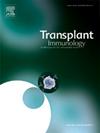Efficacy of Ruxolitinib with corticosteroids in idiopathic pneumonia syndrome post-allogeneic hematopoietic stem cell transplantation: A single-center experience and systematic review
IF 1.6
4区 医学
Q4 IMMUNOLOGY
引用次数: 0
Abstract
Background
Idiopathic Pneumonia Syndrome (IPS) after allogeneic hematopoietic stem cell transplantation (allo-HSCT) is a life-threatening complication with high morbidity and mortality. IPS is thought to arise from damage caused by various inflammatory mediators. This study assesses the effectiveness of Ruxolitinib, a Janus Kinase (JAK) 1 and 2 inhibitor that blocks cytokine production, in combination with corticosteroids (CS) for managing IPS after allo-HSCT, compared to the conventional use of CS alone in a case series and a systematic review of previously published literature.
Methods
The study includes a retrospective case series of three patients treated for IPS with Ruxolitinib and CS from the University of Kansas Medical Center and a systematic review following the Preferred Reporting Items for Systematic Reviews and Meta-Analyses (PRISMA) Statement 2020 guidelines. The systematic review encompassed seven studies involving 346 cases including three cases from the case series. Statistical analyses were conducted using SPSS v.25.
Results
The case series included three patients with IPS after allo-HSCT who received ruxolitinib and CS with favorable results. All patients showed substantial improvement with no IPS-associated mortality. Two of the three patients in the case series were discharged on a 2 L nasal cannula, which was later discontinued during follow-up visits, while the third was discharged on room air. There was marked improvement observed on the computed tomography (CT) following the use of ruxolitinib. Of the total 346 cases included in the systematic review, the median age was 46.6 years (Range 5–72), and 62 % were males. The primary disorders were acute leukemia (52 %), chronic myeloid leukemia (12 %), myelodysplastic syndrome (11 %), Lymphoma (10 %), and others (21 %). Stem cell sources were peripheral blood (45 %), bone marrow (49 %), and cord blood (6 %). Donor types involved match unrelated (55 %), match related (36 %), and mismatched related (4.5 %). Most patients received myeloablative conditioning (81 %). Acute GVHD was observed in 47 %, and chronic GVHD in 38 %. The primary treatment was CS (96 %), with limited use of ruxolitinib (1 %) and etanercept (9.5 %). The mortality rate was 63.3 %, whereas in our case series with the use of ruxolitinib, it was zero.
Conclusion
The combination of Ruxolitinib and CS for treating IPS post-allo-HSCT suggested promising results in the case series, with favorable response and improved survival by blocking the cytokine production contributing to IPS. The significant mortality difference in the systematic review supports the need for innovative treatment approaches, highlighting the potential role of Ruxolitinib in CS-refractory cases. Despite the positive outcomes in the case series, the absence of randomized controlled trials emphasizes the necessity for further research.
Ruxolitinib联合皮质类固醇治疗异基因造血干细胞移植后特发性肺炎综合征的疗效:单中心经验与系统综述。
背景:异基因造血干细胞移植(allo-HSCT)后出现的特发性肺炎综合征(IPS)是一种危及生命的并发症,发病率和死亡率都很高。IPS被认为是由各种炎症介质造成的损伤引起的。本研究评估了Ruxolitinib(一种Janus激酶(JAK)1和2抑制剂,可阻断细胞因子的产生)与皮质类固醇(CS)联合治疗allo-HSCT后IPS的效果,并对之前发表的文献进行了系统回顾:该研究包括堪萨斯大学医学中心用Ruxolitinib和CS治疗IPS的三名患者的回顾性病例系列,以及遵循《系统综述和荟萃分析首选报告项目》(Preferred Reporting Items for Systematic Reviews and Meta-Analyses,PRISMA)2020声明指南的系统综述。系统综述包括 7 项研究,涉及 346 个病例,其中 3 个病例来自病例系列。统计分析采用 SPSS v.25 进行:该病例系列包括3例IPS患者,他们在接受allo-HSCT后接受了ruxolitinib和CS治疗,结果良好。所有患者的病情均有显著改善,且无 IPS 相关死亡率。该系列病例中的三名患者中,有两名患者在出院时使用了 2 L 鼻插管,后来在随访时停止使用,而第三名患者在出院时使用了室内空气。使用鲁索利替尼后,计算机断层扫描(CT)结果明显好转。在纳入系统回顾的 346 个病例中,中位年龄为 46.6 岁(5-72 岁不等),62% 为男性。主要疾病为急性白血病(52%)、慢性髓性白血病(12%)、骨髓增生异常综合征(11%)、淋巴瘤(10%)及其他(21%)。干细胞来源包括外周血(45%)、骨髓(49%)和脐带血(6%)。供体类型包括配型无关(55%)、配型相关(36%)和错配相关(4.5%)。大多数患者接受了骨髓溶解调理(81%)。急性 GVHD 患者占 47%,慢性 GVHD 患者占 38%。主要治疗方法是CS(96%),有限使用ruxolitinib(1%)和etanercept(9.5%)。死亡率为63.3%,而在我们使用Ruxolitinib的病例系列中,死亡率为零:结论:通过阻断导致IPS的细胞因子的产生,Ruxolitinib和CS联合治疗异体HSCT后的IPS在病例系列中取得了良好的效果,并改善了生存率。系统综述中的显著死亡率差异支持了对创新治疗方法的需求,突出了Ruxolitinib在CS难治性病例中的潜在作用。尽管系列病例取得了积极的结果,但随机对照试验的缺失强调了进一步研究的必要性。
本文章由计算机程序翻译,如有差异,请以英文原文为准。
求助全文
约1分钟内获得全文
求助全文
来源期刊

Transplant immunology
医学-免疫学
CiteScore
2.10
自引率
13.30%
发文量
198
审稿时长
48 days
期刊介绍:
Transplant Immunology will publish up-to-date information on all aspects of the broad field it encompasses. The journal will be directed at (basic) scientists, tissue typers, transplant physicians and surgeons, and research and data on all immunological aspects of organ-, tissue- and (haematopoietic) stem cell transplantation are of potential interest to the readers of Transplant Immunology. Original papers, Review articles and Hypotheses will be considered for publication and submitted manuscripts will be rapidly peer-reviewed and published. They will be judged on the basis of scientific merit, originality, timeliness and quality.
 求助内容:
求助内容: 应助结果提醒方式:
应助结果提醒方式:


